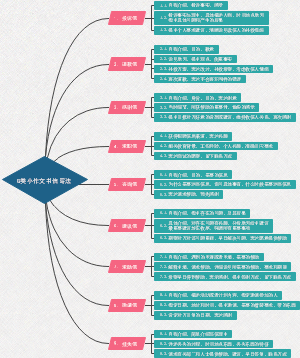导图社区 语法第36讲
- 127
- 0
- 0
- 举报
语法第36讲
新编英语语法教程——章振邦,语法第36讲修饰笔记,包括动词、形容词、副词、介词修饰语,名词修饰语和同位语三部分内容。
编辑于2022-05-16 11:07:10- 语法教程
- 相似推荐
- 大纲
修饰modification
动词、形容词、副词、介词的修饰语
动词(词组)的修饰语
通常是一些时间副词、方式副词、程度副词(表强化和弱化)等
he had already gone when I arrived
I've been thinking about it for hours, but I still can't decide.
she absolutely doesn't like him
“偏斜修饰”squinting modification:修饰语位置不当引起的歧义现象。一个修饰语(多半是副词)出现在两个动词之间,可以理解为修饰前面的动词,也可理解为修饰后面的动词
形容词、副词的修饰语
通常是一些表示强化和弱化的程度副词
You are absolutely wrong
he played surprisingly well
介词(词组)的修饰语
大多 是一些焦点副词
they followed close behind me.
I got up just at six
修饰语和状语
状语是一种修饰语,但是状语是分句成分。以上介绍的各种修饰语 是词组成分。
辨别办法:用分裂句和对比法。状语可以转换成分裂句的中心成分,可以用对比法测试出来
he reasoned extremely soundly---It was extremely soundly that he reasoned.
he arrive yesterday---it is yesterday not the day before yesterday.
名词修饰语
前置修饰语和后置修饰语
按在词组中和中心词的相互位置分为前置修饰语(premodifier)和后置修饰语(postmodifier)
前置修饰语---形容词或形容词词组、名词或名词词组、-ing分词或-ed分词,直接修饰中心词的修饰语,修饰语之间就要用逗号或并列连词
后置修饰语---介词词组、非限定分句、关系分句、某些前置修饰语的补足成分、某些教程的形容词词组
有时前置修饰语和后置修饰语互换不影响意义。
名词中心词为some-,any-, no-等合成词时,修饰语只能后置
something interesting
较长的形容词词组、非限定分句、关系分句等通常只能后置
-able结尾的形容词,前置后置意义不变,但是有些-able,-ible结尾的形容词前置和后置意义会有区别
every available fire-engine / every fire-engine available(意义不变)
the visible stars / the star visible.(前置表示永久意义,后置只表示暂时)
限制性修饰语和非限制性修饰语
名词修饰语和中心词的语义关系,可分为“限制性修饰语restrictive modifier”和“非限制性修饰语non-restrictive modifier”
限制性修饰语规定名词词组的所指意义(类别),非限制性修饰语只是作一些补充说明,后置修饰语的限制性和非限制性比较明显。
分隔修饰discontinuous modification
修饰语和被修饰语分隔的现象
介词词组分隔
Work has been started on the new system of motorways(修筑新的快车道系统的工程已经开始)
非限定分句
arrangements have been made to install safety devices on all machines.(已经作好安排,在所有机器上安装安全装置)
同位语分句
the question sometimes comes to my mind whether it was worth the effort.(有时我想到这样一个问题:是否值得花这么大的力气)
关系分句
but on the next day a swelling rapidly developed which threatened the viability of the hand.(但第二天,肿胀迅速恶化,威胁着那只手的活力)
转移修饰transferred modification
名词修饰语从表层结构看似乎是修饰跟在其后的名词,但是在意义上即在深层结构上是修饰另外的东西,叫做"转移修饰"(transferred modification),被转移了未知的修饰语叫做“转移修饰语”(transferred modifier)
I had no temptation to taking a flying holiday to the south.=to take a holiday by flying to the south
局部修饰partial modification
通常发生在以复合名词或派生词为中心词的名词词组中。前置修饰语 只修饰复合名词的第一个词素或派生词的词根
an old bookstore = a store selling old books旧书店
a historical playwright = a wright who writes historical plays历史剧作家
“a hell of a factory”等特殊修饰结构
结构形式是“det + noun + of + det + noun”,如a hell of a factory, a matchbox of a room等。被修饰对象为第二个名词
a phantom of a king = a phantom-like king有名无实的国王
多重修饰multiple modification
名词之后跟有一个以上的后置修饰语,这些后置修饰语可以是并列关系,也可能不是
the man smoking a pipe and talking to Mary
同位语appositive
起修饰和描绘作用
名词词组同位语的结构形式
同位语通常是由“名词词组”表示,紧跟在与之同位的名词词组(或相当于名词词组的结构)之后
Your brother, a proud and unbending man, refused all help that was offered him
也可位于之前
Streamlined swimmers and bloodhounds of the sea, sharks are equipped with an extraordinary sense of smell.
为了句子结构平衡或者加强语势,也可出现在句尾,造成两个同位成分的分隔
only one problem still remains — the storage of the grain.
名词词组的同位语还可以由“反身代词、不定代词、指示代词、非限定分句和名词性分句”表示
my father will go and see it himself
my friends all understand me
air, food, water, heat—these are four requirements of all living things
she liked her job, teaching English
the question who should preside over the meeting has not yet been settled.
名词词组同位语的引导词
名词词组同位语之前带有引导词表示同位成分之间的特殊意义
表示等同关系---for short, that is to say, that is
he studies linguistics, or the science of language.
表示列举和举例---for instance, for example, such as, say
Any dictionary, say Hornby's Advanced Learner's Dictionary
表示突出某点---especially, particularly,mostly
especially the one you mentioned
用介词of作引导词来表示同位关系
the city of Shanghai= the city, Shanghai
名词词组同位语的附加修饰成分
名词词组修饰语附带修饰成分,修饰作为同位语的整个名词词组
Lucy, in her youth a talented musician, still gives concerts every now and then.
修饰成分通常是一些副词和介词词组,如果出现在相应的关系分句中便是状语。
Shanghai, once the paradise for adventures...
限制性同位语和非限制性同位语
同位语和其所说明的同位成分之间的关系
大多数是非限制性的,前三节所举例子大都属于该类
限制性同位语和它的同位成分关系紧密,形成一个语义整体,口语中无停顿,在文学中不用逗号或破折号隔开
my good friend Mike
与人称代词同位的名词或名词词组也都是限制性同位语
nothing is too hard for us Chinese people.









